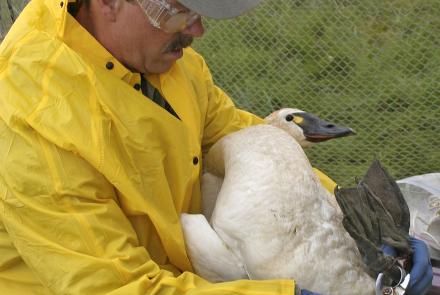The Mystery of the Denali Gap
In the northern foothills of the Alaska Range, two tiny ponds are making researchers wonder why Mt. McKinley is not a volcano.
The ponds, filled with dark water and ringed with willows, are craters, pocks left behind from volcanic explosions that happened about 3,000 years ago. Located near Buzzard Creek north of Healy, the craters are among thousands in Alaska. Called maars, the craters are smallish volcanoes that form when molten rock reaches up from within the ground and detonates as it reaches the water table. The craters near Buzzard Creek are made up of the same stuff as the Aleutian Arc. In 1912, Katmai, one of the volcanoes in the arc, hosted the largest eruption on the planet this century.
Based on the chemical signature of rocks found near the Buzzard Creek craters, Mt. McKinley and the rest of the western Alaska Range should be volcanoes, said Chris Nye with the Alaska Volcano Observatory. But Mt. McKinley and its neighbors are not volcanoes, and that raises questions about both the Buzzard Creek craters and the Aleutian Arc.
Extending east from Russia’s Kamchatka Peninsula, the Aleutian Arc curves in a crescent that would extend from San Francisco to St. Louis if superimposed on the U.S. Most of the arc is visible as the Aleutian Islands, which are pimpled with about 100 volcanoes. The northernmost volcano in the arc, Mt. Spurr, is located across Cook Inlet from Anchorage. Volcanic activity seems to end there, but if the curve of the Aleutian Arc were to extend north, it would meet the Alaska Range. The Alaska Range features no volcanoes until the craters at Buzzard Creek. Nye calls the non-volcanic area between Mt. Spurr and Buzzard Creek “the Denali Gap.”
The area of the Denali Gap—a 200-mile stretch filled with big mountains—has all the ingredients for volcanic activity, but no volcanoes. One element necessary for volcanoes is subduction, a process in which one of Earth’s plates—a giant hunk of crust—dives below another. Beneath the Denali Gap and much of Alaska, the Pacific plate grinds underneath the North American plate. As the Pacific plate descends, it gives off water and other fluids that mix with dense rock to form molten rock; that molten rock sometimes rises to form a volcano. Most of the Aleutian volcanoes are located about 60 miles above where the Pacific plate meets the North American plate. The Buzzard Creek craters and the mountains of the Alaska Range are located about 60 miles above the interface of the giant plates. Why do volcanoes exist in the Aleutians but not the Alaska Range?
Nye said a large number of earthquakes recorded in the Alaska Range indicate that subduction is still happening beneath the mountains, but something has stopped the formation of volcanoes between Mt. Spurr and Buzzard Creek. What?
One theory is that a block of crust under southern Alaska is being plastered to the North American plate so firmly that molten rock can’t make its way to the surface in the western Alaska Range. Nye said scientists also once believed that the Pacific Plate dried up on its journey beneath the North American plate before reaching Mt. McKinley. But volcanologists have found evidence of the very same wet stuff that produces volcanic activity in the Aleutian Arc near the craters at Buzzard Creek. As they find more clues from places like the Buzzard Creek ponds, volcanologists and seismologists hope to find out why Mt. McKinley and other Alaska Range mountains aren’t spouting ash and belching sulfur.




